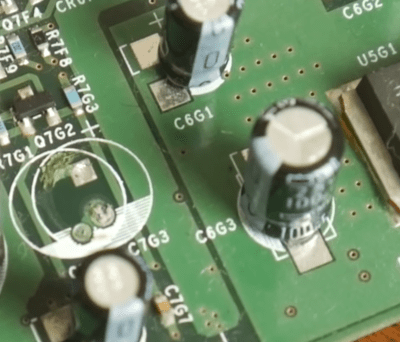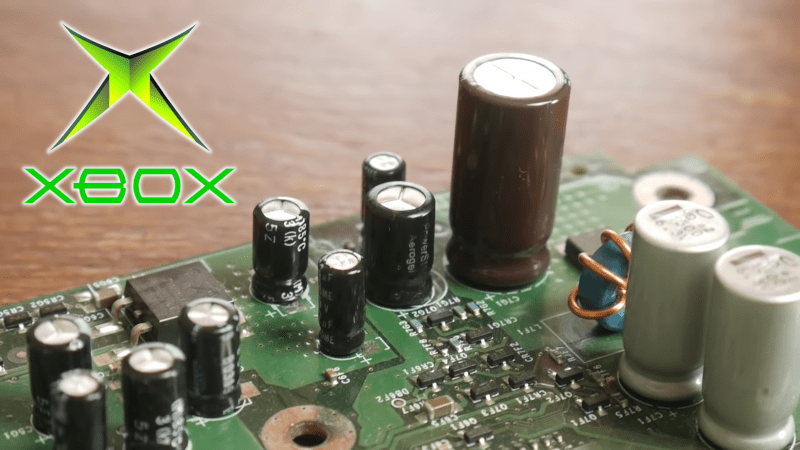Fans of retro computers from the 8-bit and 16-bit eras will be well aware of the green death that eats these machines from the inside out. A common cause is leaking electrolytic capacitors, with RTC batteries being an even more vicious scourge when it comes to corrosion that destroys motherboards. Of course, time rolls on, and new generations of machines are now prone to this risk. [MattKC] has explored the issue on Microsoft’s original Xbox, built from 2001 to 2009.

The original Xbox does include a real-time clock, however, it doesn’t rely on a battery. Due to the RTC hardware being included in the bigger NVIDA MCPX X3 sound chip, the current draw on standby was too high to use a standard coin cell as a backup battery. Instead, a fancy high-value capacitor was used, allowing the clock to be maintained for a few hours away from AC power. The problem is that these capacitors were made during the Capacitor Plague in the early 2000s. Over time they leak and deposit corrosive material on the motherboard, which can easily kill the Xbox.
The solution? Removing the capacitor and cleaning off any goop that may have already been left on the board. The fastidious can replace the part, though the Xbox will work just fine without the capacitor in place; you’ll just have to reset the clock every time you unplug the console. [MattKC] also points out that this is a good time to inspect other caps on the board for harmful leakage.
We’ve seen [MattKC] dive into consoles before, burning his own PS1 modchip from sourcecode found online. Video after the break.
Edit: As noted by [Doge Microsystems], this scourage only effects pre-1.6 Xboxes; later models don’t suffer the same problem, and shouldn’t be modified in this way.
















so much for the permanence of “solid state” when it must be surrounded by passive components filled with weird liquid.
Solid polymer caps started replacing electrolytics in high-stress locations in the late 00s, and now even the humble arduino sports a couple of them for power smoothing
Interesting. Are these solid poymer capacitors a direct 1:1 replacement on any board for electrolytics or are they conditions that prevent certain boards to have these nice replacements?
I’m not expert but I’ve read somewhere than solid polymer caps (at least SMD ones) can explode so they seems to be more fragile than electrolytics and thus not a suitable, 1:1 no-brainer, replacement
Solid capacitors can replace some electrolytics, but each have their own strength and weaknesses.
Electrolytics typically work better for power supply noise filtering and can tolerate some over-voltage and reverse voltage spikes if they are not sustained. They also handle more power dissipation due to size and construction.
Solids are more compact and can be used in locations where vibration is high, but you’ll still see a lot of electrolytics on surface mount boards due to the reasons above as well as being less expensive.
Thanks, si currently (2020), no solution exist to completely eradicate/replace electrolytics capacitor on a random PCB if I understand correctly? If so does any company working on this topic or it’s uncharted territory ?
I’ve got the impression that lithium batteries got all the attention but a major untapped potential resides in this field.
The bad Capacitors you were targeting at are not only used with solid state components and they were used right from the start of electronics up to now. Even electrolytic capacitors. And there are still electrolytic capacitors out that still maintain their functionality and capacity even after 40 years of lifetime or more. On the other hand there are solid state components that did fail for aging after 10-20 years. Oxygen or maybe even worse humidity did find it’s way into the components, it corroded the pins and the internal bonding wires, the contact surfaces where bonding wires are welded to, contacts did fail or get noisy then and your pretty integrated circuit failes.
So, it does not have to do anything with solid-state or not. It is always the fabrication process that maintains the quality of the components – and this may have some price for a good process!
These problems also do show up passive elements like resistors coils or capacitors. They also show up in tube electronics (they lose their vacuum at seals, heater wires do “burn”), relay based circuits (contact corrosion, mechanical getting stuck) but very same in high-tech processor systems (aging from heat, maybe sometimes even corrosion inside the component or at it’s outer contacts.)
As always – there are no theoretical perfect components out on the market. You always have to respect physical limitations and we will have to do so in the future as well.
Between its achey-breaky capacitors and slow and troublesome DVD drive, the original Xbox is one of the best consoles to replace with an emulator. Looks like good progress is being made on xemu!
That’s why you softmod it and drop in a massive SATA HDD, a SATA-to-PATA adapter, and an Ultra ATA ribbon cable. Internet Archive maintains a near complete library of Xbox games to download. I love my TSSOP’d Xbox but it’s definitely started to become outdated when HD movies and TV shows started appearing online. XBMC could barely handle displaying 720p video and it got replaced as my streaming device back in 2010 when 1080p streaming boxes got cheap. Now, it’s just a repository of games that I haven’t touched in some time. There are some great all-in-one emulator suites you can find but N64 barely works and some arcade games (Chihiro) are impossible to run unless you feel like soldering new RAM chips in. The added RAM is able to be used by a lot of the homebrew software so it’s a worthwhile upgrade if you really love your Xbox. Emulation of the original Xbox is not great. It’s never gotten enough love and everyone moved on to the 360. The best Xbox emulator is the one inside the Xbox One but that’s not really the point, eh?
“Looks like good progress is being made on xemu!” You mean that guy Scientologists worship (not L. Ron Hubbard, the other space alien guy.)
Considering the console has been out for 20 years and the vast majority of titles still can’t be emulated, I’m not holding out a lot of hope. But I’d love to see one of the open source projects actually make some real progress. You’d think being an x86 console would help.
It’s worth noting that this only affects v1.0 – v1.5 motherboards. v1.6 doesn’t have the clock capacitor.
Other then cracking open a case is there some way to tell what version your motherboard is by the serial number product number or label?
Yes it has. It’ right at the edge of the IDE connector, a golden Nichicon one. And they start to fail too, but it seems the electrolyte is not that corrossive, or because they started to fail later, possibly had no time to do noticable damage. Anyways 1.6s need a clock cap to even boot, but can be replaced by “any” electrolytic cap, doesn’t have to be a supercap.
I have got some people asking for an LPC adaptor, which is present on the XBOX1, now there is one here (based on an STM32 and a Teensy):
https://randomprojects.org/wiki/Openbiosprog
https://www.flashrom.org/Teensy_3.1_SPI_%2B_LPC/FWH_Flasher
This is an extensively published problem and the capacitor has been torn out by loads of people preemptively for at least 10 years.
Ah, RTC batteries! That’s what killed the GameCube I’ve had for almost 20 years. Luckily the RTC battery is on the little daughterboard the controller ports are on, and I was able to swap that board out easily and on the cheap.
These old PowerStors sure do love to leak. At a previous job, we had a product that used a pair of 10F PowerStors, and they sometimes leaked too. But you can also find gold Nichicon supercaps in an Xbox, and those are supposed to be good.
The best long-term fix is to solder a header into the wider pair of holes (after tediously cleaning out the nasty solder), then plug in a wire to a supercap off to the side. I used a leftover cap from that previous job (10F should keep the clock running a bit longer) as a replacement. I also had to put back Q7G2 that fell off (at least I caught it!). It was a lot of work to get clean solder on the pads so I could put it back, but eventually I had three tiny balls of solder poking through the muck.
Now if only something could be done about the infamously flaky optical drives.
Should I store my Xbox upside down to keep the caps from dripping onto my motherboard?
it is, of course, a completely different machine, but, a few months ago, my 15yo miele washing machine started to work erratically, stopping mid-program, giving errors. i opened it of course, but at first sight, i did not find anything, so we had someone come over, from the company, since it was, in it’s time, a quite expensive buy. he checked the electronics, and found some errors, which he cleared, with the hope that it would work properly again, in case not, he offered a generous rebate, if we bought a new machine from the company. it did actually work 2-3 times, but started being erratically again. since we (my wife and me) had already resigned to buy a new machine, we decided, that it doesn’t matter, so i removed the electronics “brain” and had a closer look at it, and voila, at the edge of a capacitor, i saw something like a liquid having stained the PCB. so, enter the soldering iron, i removed the capacitor, and replaced it (and the 4 other electrolytic ones) with new ones from my stash, and tada! it works again flawlessly, possibly for another 15 years ;)
is this alao the reason why it smokes when its plugged